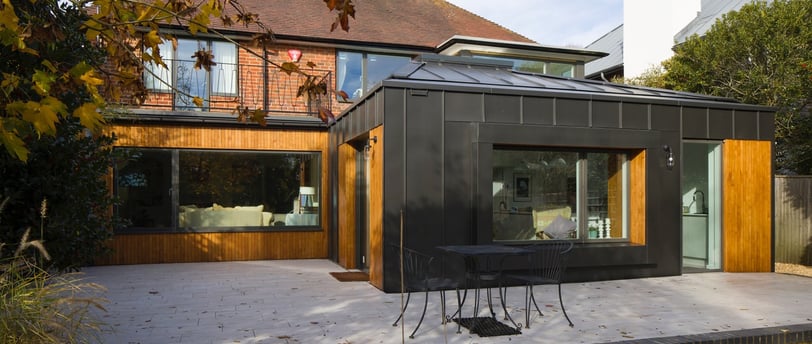Single-Storey Extensions UK 2025 | Design Ideas, Costs & Rules
5/19/20253 min read


Single-Storey Extensions UK: Costs, Designs & Planning in 2025
Thinking about more space for your growing family or a brighter, open-plan kitchen? A single-storey extension is one of the most cost-effective ways to transform your home in the UK — without the complexity of a double-storey build.
In this post, we’ll explore everything you need to know about single-storey extensions in the UK — from design ideas, costs, and planning rules to top mistakes to avoid in 2025.
Why Choose a Single-Storey Extension?
Single-storey extensions are ideal for homeowners who want:
A larger kitchen or dining area
Open-plan living space
A downstairs bedroom or bathroom
Seamless access to the garden
More natural light and a modern layout
🛠️ Fact: In most UK cases, single-storey rear extensions fall under Permitted Development Rights, meaning no full planning application is needed if built within the rules.
Popular Types of Single-Storey Extensions
Here are the most common types across the UK:
1. Rear Extensions
Perfect for expanding kitchens, dining rooms, or living areas.
Typically built into the garden space
Can include bi-fold doors and skylights
Easy to integrate with the original layout
2. Side Return Extensions
Popular in Victorian or Edwardian terraced homes.
Uses the unused alleyway space at the side
Creates wide, open-plan interiors
Works well with pitched or flat roofs
3. Wraparound Extensions
Combines rear + side return for maximum floor space.
Adds dramatic space and flexibility
Ideal for large open kitchens and dining areas
May require planning permission due to scale
Single-Storey Extension Ideas for 2025
Make your extension future-ready and functional. Here are the top design ideas homeowners are loving in 2025:
🪟 Crittall-style doors and floor-to-ceiling glazing for indoor-outdoor flow
🪴 Internal courtyards for light and privacy
🍽️ Kitchen islands with skylights above
🧼 Downstairs wet room or utility extension
🧘♀️ Home office or wellness studio
Trend Tip: Use eco-friendly materials like reclaimed brick or green roofing to future-proof your design.
What Are the Rules? (UK Permitted Development)
Most single-storey rear extensions are allowed under Permitted Development Rights, as long as you follow these limits:
For most homeowners, a single-storey rear extension can be built under PD rights if it does not exceed 3 meters in depth for a terraced or semi-detached house or 4 meters for a detached property. In terms of height, the overall extension must not go beyond 4 meters, and the eaves height (where the extension meets the existing wall) must not be higher than 3 meters if it is within 2 meters of the property boundary.
Materials used in the extension should be similar in appearance to those used on the existing house. This helps ensure the extension blends with the original building style and doesn’t stand out as an eyesore.
✅ Must not cover more than 50% of the original garden
✅ Must be behind the principal elevation
✅ Must not extend forward of the front wall
Always check with your local planning authority before starting, especially if you're in a conservation area or own a listed building.
How Much Does a Single-Storey Extension Cost (UK 2025)?
Average Cost (London upto 15 m²): £30,000–£40,000
Average Cost (London upto 25 m²): £45,000–£60,000
Average Cost (London upto 35 m²): £65,000–£90,000
Average Cost (outside London upto 15m²): £25,000–£35,000
Average Cost (outside London upto 25m²): £35,000–£50,000
Average Cost (outside London upto 35m²): £50,000–£75,000
What’s included:
Foundations and structure
Roofing and insulation
Windows/doors
Internal finishes (floors, plaster, electrics)
💡 Don’t forget: You may also need to budget for architectural design, planning consultants, and structural engineers.
Do You Need Planning Permission?
Only if:
You exceed the PD size limits
Your property is in a protected area
You’re extending forward of the front elevation
You’re making changes to a listed building
🧩 Good news: Under the Larger Home Extension Scheme, you can extend up to:
6 metres (terraced/semi-detached)
8 metres (detached)
…but you'll need to go through a Neighbor Consultation Scheme.
Building Regulations for Single-Storey Extensions
Even if planning permission isn’t needed, building regulations approval is mandatory. This includes checks on:
Structural integrity (foundations, load-bearing walls)
Insulation and energy performance
Ventilation and drainage
Electrical and fire safety
A building inspector from your local authority or private firm will inspect works at key stages.
Top Mistakes to Avoid
❌ Starting without checking PD rules
❌ Ignoring neighbors—always consult them
❌ Hiring unqualified builders
❌ Choosing poor-quality materials to cut costs
❌ Forgetting about natural light or ventilation
❌ Not factoring in garden access during build
Real UK Case Study
A homeowner in Leeds created a 30m² kitchen/diner extension using bi-fold doors and skylights. The project:
Fell under permitted development
Took 3 months to complete
Increased property value by £45,000
Improved family life with more open space and garden access
FAQs
How long does a single storey extension take to build?
Usually 10–14 weeks, depending on size, weather, and complexity.
Do I need an architect?
It’s highly recommended to ensure good design, efficient use of space, and accurate drawings for regulations.
Can I live at home during the build?
Yes, most homeowners remain onsite, although some disruption is expected.
Final Thoughts
A well-designed single storey extension is one of the smartest investments UK homeowners can make in 2025. It adds space, comfort, and value — all without the major planning red tape of larger builds.
Whether you're dreaming of a sleek kitchen diner or a tranquil garden room, planning it right from the start ensures smooth construction and a beautiful finish.